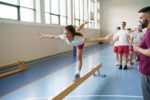We are partnering with CrossFit Kids to bring you information to help encourage and inspire your children to incorporate health and fitness into their every day lives and to improve their ability to learn. It’s important for all online school students to spend some time every day moving, playing, and exercisingnot only because in some states it’s required, but because the overall benefits to health and learning are immense!
However, It is very important that you consult a doctor before you or your children begin any type of exercise. Always stop exercising immediately if you experience any shortness of breath, dizziness, or pain.
The posts provided by CrossFit Kids in this series are designed to explain the overall philosophy of CrossFit Kids, review some basic movements, and offer suggested workouts that can be incorporated at home. We will be reviewing different movements throughout the series and providing you with ideas to get your kids moving. The workouts won’t be anything you can’t handle and you should, by all means, join in!
Remember, this should be fun! Are you ready? 3, 2, 1…Go!
Walk midway into a class at a registered CrossFit Kids program and you might discern the kind of energy that usually emanates from a playground during recess. There is joyful noise: laughter and thrilled shrieks and triumphant shouts. Kids are having a blast. And the trainers look like they might be having an even better time. A well-run program always looks like a boatload of easy fun. But all of that fun, as merrily hectic and aimless as it sometimes seems, is by design, purposeful. CrossFit Kids intends to teach children to associate exercise with fun, with the ultimate goal being that they will value the pursuit of fitness into adulthood. It is the new school when it comes to physical education.
But when parents find themselves acting as their child’s learning coach at home, that sense of easy fun can become decidedly uneasy. The urge to get their children to a registered CrossFit Kids program can become strong. But that is not necessary.
The following overview is intended to provide some basic guidelines on how parents can put the CrossFit Kids curriculum into action.
Keep It Simple
Parents should review the CrossFit Kids General Age-Appropriate Guidelines and, at the beginning, err on the side of easy to ensure that the mechanics of the movements are privileged above all else. As part of their own learning, parents should refer often to the CrossFit Kids instructional posts; performing the movements themselves will help significantly when parents begin teaching them to their children. Certainly at the outset, we recommend that parents follow the provided programming as closely as possible because the curriculum is designed to support the less experienced instructor and with the most basic home gym environment in mind.
If parents require clarification on any of the CrossFit Kids instructional posts, they are encouraged to direct detailed inquiries to info@crossfitkids.com.
Keep It Fun
Class Structure
From start to finish, a CrossFit Kids builds fun into the structure of the class. The framework is essentially the same from preschool through teen, with some changes as the kids get older, particularly in terms of class length. Duration is based on CrossFit Kids’ experience with the typical attention span of children as they mature. Keep the children engaged only as long as they are developmentally able to remain engaged and then leave them wanting more.
Preschool (ages 35):
Explanation
Focus/Skill Work
Warm-Up
Workout of the Day (WOD)
Game
Class Length: 1520 minutes
Elementary (ages 512):
Explanation
Warm-Up
Focus/Skill Work
WOD
Game
Class Length: 30 minutes
Preteen (ages 1012)
Explanation
Warm-Up
Focus/Skill Work
WOD
Challenge
Class Length: 30 minutes
Teen (ages 1218)
Explanation
Warm-Up
Focus/Skill Work
WOD
Cooldown/Skill Work
Study Hall
Class Length: 4050 minutes
Specifically, the Game
For the preschool and elementary sessions, the game is a non-negotiable component. Every session must end with the game. It is what the kids are working toward and it is the primary reason they can’t wait to do CrossFit Kids again.
Specifically, the Challenge
Preteens have hit a point where the CrossFit Kids games are not quite as entertaining as they used to be. Preteen sessions end with a bit of skill work arranged in a game-like format. Challenges test a variety of athletic areas, e.g., jumping ability, balance, coordination, and midline stability, and a child strives to beat his or her current best effort, which in this age group provides a fun way to end the session.
Fun Changes over Time
For teens, competition and achievement are now intrinsic to their sense of fun. Whether it is going up against the clock or lifting more weight than they did last week or accomplishing something for the first time after putting in time and effort, teens derive satisfaction directly from the work. The need to end every session with an activity identified specifically as fun is no longer necessary; teens are looking to beat the clock, realize goals, and see themselves getting better.
The Language of Learning
Anyone can grasp the mechanics of the functional movements at the core of the CrossFit Kids curriculum well enough to teach them. Getting kids to move in some semblance of the manner seen in the CrossFit Kids demo videos is also doable. But what happens after a parent achieves this?
The crux of the program is in refining the movements over time such that your kids first become good movers, then excellent movers. Accomplishing this requires consistent instruction that not just communicates corrections but encourages kids to keep working.
Cues should always be positive. Do this rather than Don’t do that. Try this rather than Stop doing that.
For children, the cues should be sandwiched between compliments. The old criticism sandwich. Praise them, provide the cue, and serve up another compliment. This is simple and quite effective.
However, as any parent of a teenager quickly learns, this age group often requires a delicate touch. We want be particularly sensitive to the heightened emotions teens experience. Further, our positive coaching cues should always carry a respectful tone appropriate for kids beginning to view themselves as young adults and the delivery may need to be a little more nuanced than a simple criticism sandwich. Ideally, in keeping with the Positive Coaching Alliance’s thinking, we look to offer a teen five positives for every correction.
Know When to Say When
The optimum length for CrossFit Kids classes is based on many combined years of experience. However, there are times when certain class components don’t work the way we planned. Stop. Move on to the next thing, or if the last module falters, call the session for the day. The goal is to end each component, and especially each session, on a high note when the fun is rampant. Always strive to leave `em wanting more.
And it should go without saying that at any time things appear unsafeSTOP immediately.
Keep It Real
In practical terms, a CrossFit Kids session can be done just about anywhere with minimal equipment. Children can run, jump, squat, and do push-ups and burpees in the backyard or at the park. On a rainy day, a complete and effective session can be run in the garage and maybe even in the family room. Over time, as the curriculum introduces additional exercises, basic equipment can be added. Although investments in jump ropes and light dumbbells might eventually be necessary, other things can be found without purchase; e.g., a park might yield a pull-up bar and benches on which to jump, and the family shed might hold scraps of PVC pipe or a broomstick.
Again, contact info@crossfitkids.com for ideas on equipment substitutes and answers to questions.






















































































































